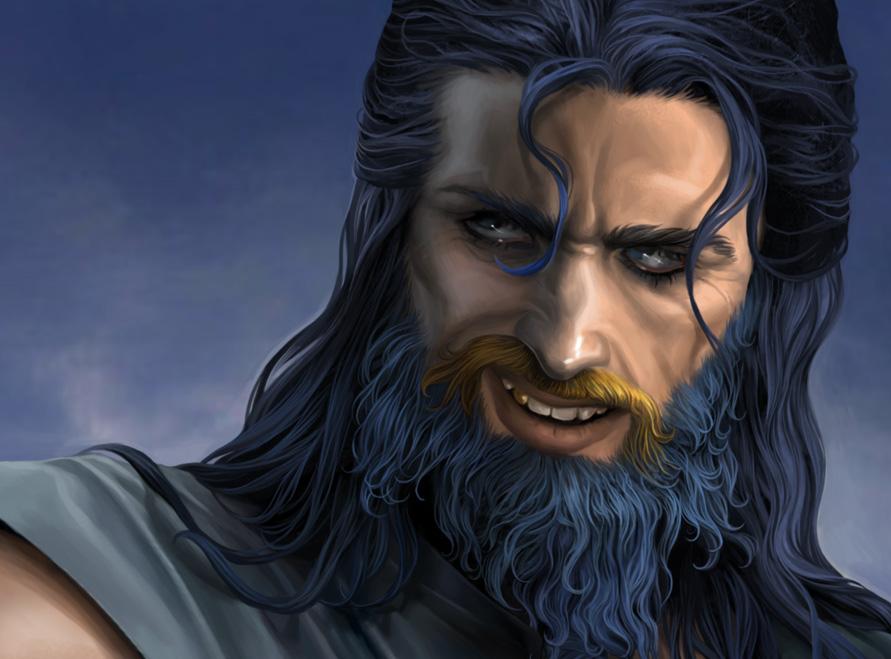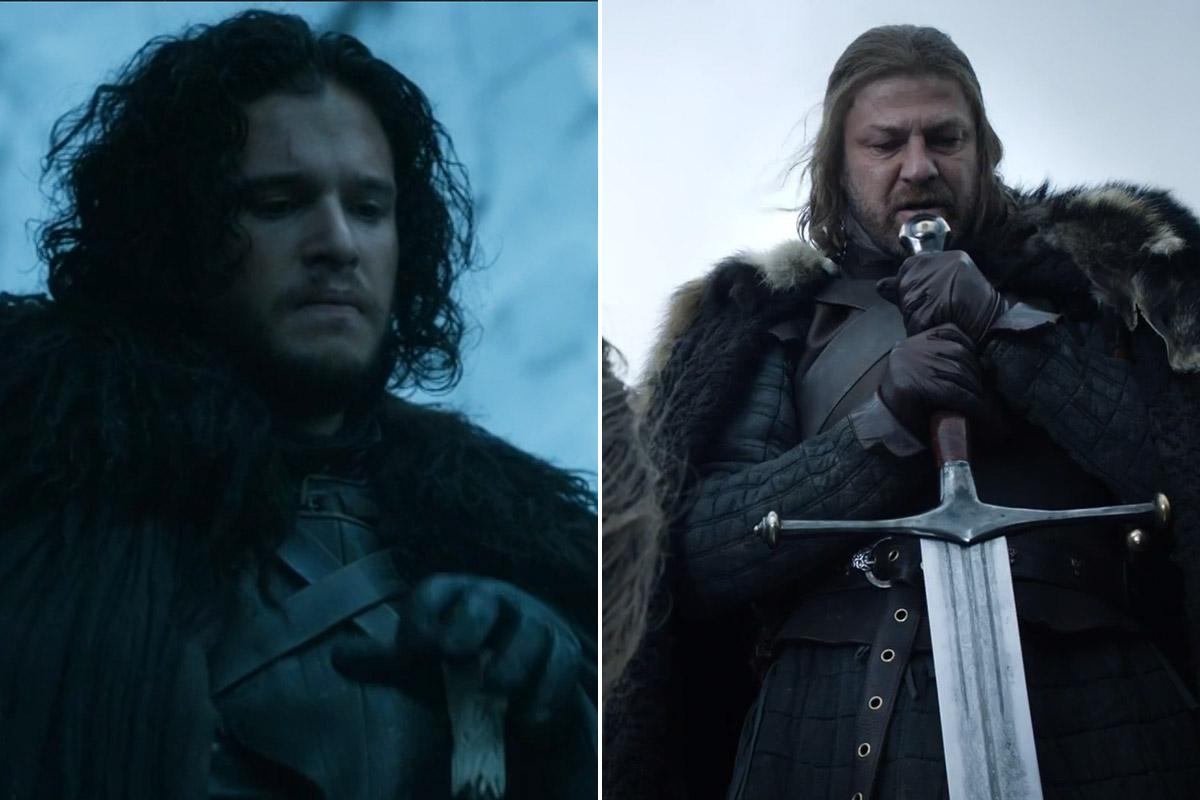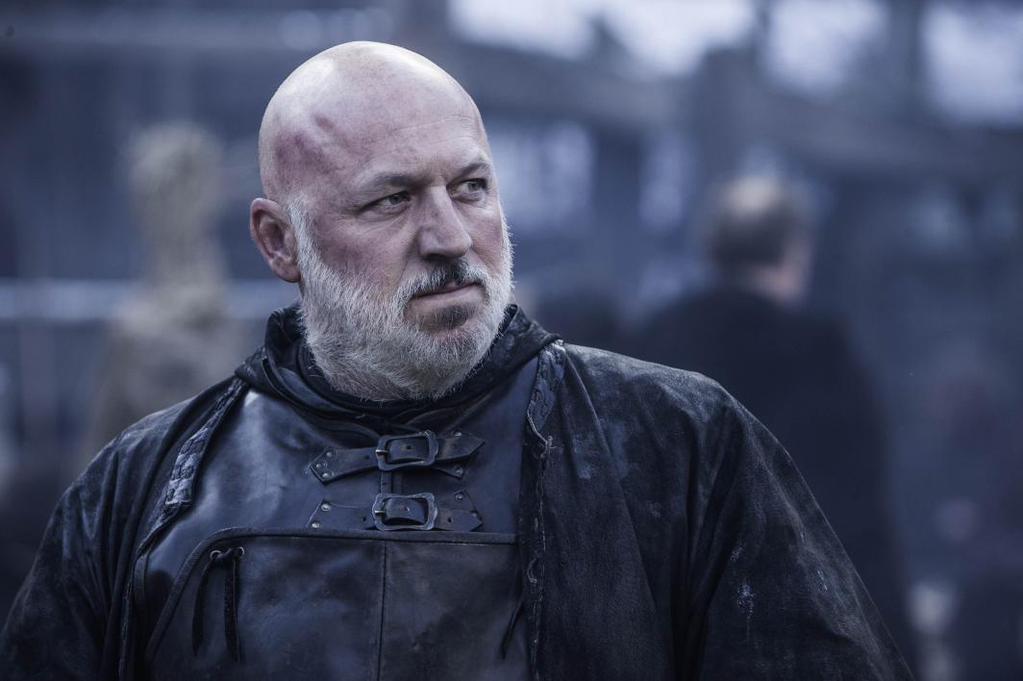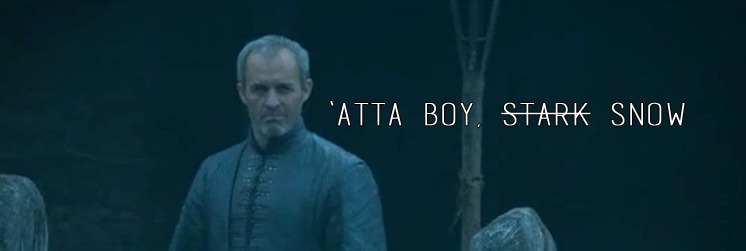Note from the author: my most sincere apologies for having this article be a week late; a combination of personal, professional, and literary factors (my new Tower of the Hand book releases today!) all conspired to derail my schedule for the past two weeks. All I can do is beg your forgiveness and promise this week’s article is still on time for tomorrow.
HBO’s Game of Thrones (typically, and before this current season) brandishes a consistent and high degree of fidelity to the nearly 5,000-page-long source material of George R.R. Martin’s A Song of Ice and Fire novels, but there still, of course, are differences. While most of these gaps from the page to the screen are small and detail-oriented, it is nonetheless the case that the most subtle discrepancies often hold the biggest insight into the adaptation process, into the demands of filmmaking, and into the rigors of the literary narrative.
This, then, is the anatomy of a key scene of Thrones – not because of its dramatic importance or visual effects whizbangery, but because of the telling nature of its realization.
Episode: “High Sparrow” (503)
Scene: Jon executes Lord Janos
The sequence where Lord Commander Jon Snow executes Lord Janos Slynt is one that is incredibly faithful to the book – something of a growing rarity this season, with the unprecedented number of changes that showrunners Dan Weiss and David Benioff have instituted on practically a minute-by-minute basis. But what changes there are are extremely telling of not only the demands of a visual adaptation, but also of the particular approach that showrunners Dan Weiss and David Benioff have long adopted for their television series.
To really dig into the nitty-gritty details and embark on a full-blown analysis, it will behoove us to, firstly, back up to the beginning of the sequence, to the meeting in Castle Black’s great hall, and, secondly, to quote the corresponding scene from A Dance with Dragons nearly in full:
“Lord Janos.” Jon sheathed his sword. “I am giving you command of Greyguard.”
That took Slynt aback. “Greyguard… Greygaurd was where you climbed the Wall with your wildling friends…”
“It was. The fort is in a sorry state, admittedly. You will restore it as best you can. Start by clearing back the forest. Steal stones from the structures that have collapsed to repair those still standing.” The work will be hard and brutal, he might have added. You’ll sleep on stone, too exhausted to complain or plot, and soon you’ll forget what it was like to be warm, but you might remember what it was to be a man. “You will have thirty men. Ten from here, ten from the Shadow Tower, and ten lent to us by King Stannis.”
Slynt’s face had turned the color of a prune. His meaty jowls began to quiver. “Do you think I cannot see what you are doing? Janos Slynt is not a man to be gulled so easily. I was charged with the defense of King’s Landing when you were soiling your swaddling clothes. Keep your ruin, bastard.”
I am giving you a chance, my lord. It is more than you ever gave my father. “You mistake me, my lord,” Jon said. “That was a command, not an offer. It is forty leagues to Greyguard. Pack up your arms and armor, say your farewells, and be ready to depart at first light on the morrow.”
“No.” Lord Janos lurched to his feet, sending his chair crashing over backwards. “I will not go meekly off to freeze and die. No traitor’s bastard gives commands to Janos Slynt! I am not without friends, I warn you. Here, and in King’s Landing, too. I was the Lord of Harrenhal! Give your ruin to one of the blind fools who cast a stone for you – I will not have it. Do you hear me, boy? I will not have it!”
“You will.”
Slynt did not deign to answer that, but he kicked the chair aside as he departed.
One of the most striking differences between the two versions is the slight reworking of Janos Slynt’s character, a practice which Benioff and Weiss started immediately, from the first season (he was first introduced in “Cripples, Bastards, and Broken Things,” episode 104): gone is the more expressive – some might say more cartoony, given the extreme similarity of the literary version of Lord Janos to the character of Gonza from Hayao Miyazaki’s masterpiece, Princess Mononoke – mannerisms, such as the immediate reddening of his face (or the general frothing at the mouth that all but sprays out of the page in other exchanges from other volumes). Also gone is the rather peculiar construction of the lordling’s speech patterns, which, while never quite as pronounced as, say, the Braavosi syntax (“A man needs a name…”), was still a deft touch that helped to simultaneously make the character stand out while also engaging in some world-building, giving the reader the impression of a full spectrum of regional accents and colloquialisms from across the Seven Kingdoms.
Why would the executive producers lose it? It may be because the actor they cast, Dominic Carter, seems more naturally prone to the severe than to the buffoonish, but the answer more than likely squarely resides in Weiss and Benioff’s desire to strip as much color out of Game of Thrones, both literally and figuratively, as possible, a practice which has been seen time and again since the pilot first aired. The most illustrative example here would be of Daario Naharis, who, in the source material, brandishes a three-pronged, blue-dyed beard, gold-painted mustachios, a gold tooth, blue hair, and extremely loud clothing – which is perfectly representative of many Essosi societies. Since the television series already features dragons, blood magic, and 700-foot walls made from ice, the thinking on the producing staff probably goes, it’s probably best to keep things as “realistic” as possible, particularly considering that the show is meant to feel more like a period piece than, say, The Hobbit.

There are also, of course, the usual immediate alterations in location, background action, and exposition (such as the removal of the subplot of Stannis providing some of his own men to garrison the Wall, which, in the series, changes to the would-be king needing the wildlings to fight for him). In the novel, Slynt comes to the lord commander’s (makeshift) office, arriving several hours late and catching Jon in the middle of cleaning his Valyrian sword, Longclaw, which is a bit of business that, in Martin’s handling, becomes an important piece of characterization for both of them: for Jon Snow, it illustrates his willingness to do for himself some of the menial practices that would ordinarily be left for his steward (a point which the author directly spells out); for Janos Slynt, his stubborn refusal to acknowledge a barred blade conveys just as much disrespect for the bastard boy as does his tardiness.
Jon’s humility and extraordinary patience continues immediately after this scene, when the action jumps to the next morning and finds Lord Janos breaking his fast in the common room, continuing to flout his orders. All eyes fall on the lord commander as he calmly states, “I will give you one last chance. Put down that spoon and get to the stables. I have had your horse saddled and bridled. It is a long, hard road to Greyguard.” The order for execution, of course, inevitably lands next, although here, on the page, Jon first calls for him to be hanged before changing his mind – and recalling his lord father’s edict that the man who issues the order must be the one to swing the blade (“Winter Is Coming,” 101) – and beheads Janos Slynt himself.
It’s important to note the compression of the two parts into one continuous sequence for the series, a necessary accommodation for pacing; with each scene burning through so many pages of text per second (even the imaginary ones for this season), and with so many scenes jam-packed into every episode, everything must be condensed as much as humanly possible. But it’s even more instructive to see how, even with the loss of Jon’s internal monologue and the elongated period of time, the exec producers still manage to translate the characterization that Martin worked into every nook and cranny of the events: Jon Snow’s verbal sparring with Lord Janos might have none of the Zen-like calm from Dance with Dragons, but, then again, he has none of his literary counterpart’s hesitation regarding execution methods. Thus, the resoluteness of the Lord Commander’s character is still demonstrated – and the writers are able to make manifest to the audience the undercurrent of disdain that Martin’s inner monologues were able to convey privately to the reader. It is a deft, if perhaps subtle, reworking of the material.



This is a nicely written piece. A few other points stand out in terms of the adaptation as well:
–The exaggerated speech patterns and facial expressions may be gone, but the writers did take care to make sure to portray Janos as more puffed-up than just about any other character, hence the frequent refrain of the “I have powerful friends at court” that he employed both for Tyrion in Season 2 and now, and his insistence on leaning on his resume as head of the City Watch. No other character so frequently referred to his past accomplishments, and so even without the need to refer to himself in the third person a la Ike Turner, it was enough to make his speech distinctive.
–Another layer that was eliminated was his exposure to some of the others by Stannis Baratheon, who lashed out after Janos simpered about being appointed Lord Commander by Stannis as a way to break the logjam. The ongoing battle between Slynt, Thorne, Cotter Pyke and Denis Mallister is eliminated because the show’s version of Slynt is such a craven to begin with that to have him even stand as a possible Lord Commander would have seemed ridiculous.
–The brief shot of Jon drinking alone in the common room after everyone else steps outside perfectly shows how isolated he is now as the leader – uneasy lies the crown and all that. It’s just a moment, but it’s so nicely shot, with the light streaming in, and you get the gravity of the situation. Or as Omar Little would have put it, “You come at the king, you best not miss.”
–Jon doesn’t hesitate in terms of his execution method, but notably stops for a moment after Slynt begs for mercy. His line, “I’m afraid, I’ve always been afraid” was a nice, humanizing moment for a vicious jerk.
Good work!
You’ll sleep on stone, too exhausted to complain or plot, and soon you’ll forget what it was like to be warm, but you might remember what it was to be a man.
I think George’s best strength is what he chooses to reveal and not reveal from the character’s mind during dialogue. You get strong, albeit sexist, thoughts like this all the time. And when it comes to really heated scenes, you don’t hear the character’s thoughts, and it adds to the reader’s tension.
That said, I hope D&D continue to strip all of the unrealistic colour out of cartoonish characters, they’ve done a great job making Cersei, Janos, Roose, Varys and Daario believable humans
These “Anatomy of a Scene” articles are probably my favorite part of this site. Keep up the good work!
A printed page needs touches like distinctive speech patterns in order to differentiate one character from the dozens of others around them.
A TV show doesn’t need that sort of indicators, since they have a living, breathing actor to distinguish each character from the next.
Greatjon of Slumber,
A+ for an Omar Little reference!
I think all of the characters on screen (not including the newest ones that we haven’t had enough time with) act like real, unique people. Sam, Tyrion, Cersei, and other extreme personalities still fall within the realm of believable.
Hear, hear!
These pieces are always thoughtful (and thought provoking), well written, and a real pleasure to read!
Thank you.
Another great read, especially since this scene is one of my favorites in ADWD. In fact, this has become my favorite column on the site. I’m definitely looking forward to your commentary on the implications of Barristan the Bold (a true badass in the books) meeting an all-too-early death. In my opinion, it was a sloppy way to trim the cast and does a great disservice to the upcoming climactic moments of the Mereen plot.
A man is forgiven 🙂
Thanks for another good read
HARmundGiantsbane,
This implies those climactic moments haven’t already been cut.
“HBO’s Game of Thrones (typically, and before this current season) brandishes a consistent and high degree of fidelity to the nearly 5,000-page-long source material of George R.R. Martin’s A Song of Ice and Fire novels”
I’ve highlighted the key words. This season is dramatically different than the others in terms of fidelity to the books. As far as I can tell, only three moments in E4 came from the books – Jon and Sam sending letters to various lords (with an astute swap of Tommen for Roose), Tyrion’s dress-down of Jorah (the setting was change but the dialogue fundamentally the same) and Obara’s horribly out-of-context monologue. Everything else was made up.
Of course we will still get book moments, and some will be great as was Slynt’s execution, but their number is really dwindled compared to what we saw in previous seasons.
Nice one, Marc.
One thing worth mentioning is that Aemon’s Kill the Boy speech (coming as previewed in ep5) was actually given to Jon before Slynt’s beheading in ADwD. To me, it was a combo of Aemon’s words and Ned’s words about “the man who delivers the sentence…” that made Jon change his mind regarding the execution. As you stated, the execution scene is more “continuous” in GoT but I find it interesting that Aemon’s “Kill the Boy” speech is being portrayed after the execution and not before.
Obviously, the speech is meant to prepare Jon for upcoming major (and very unpopular) decisions later in Jon’s arc (maybe later in the same episode) but I find the scene reordering quite interesting. Any thoughts on that?
Very nice! Thank you Marc! 🙂
Personally, as someone who’s not into the magic side of things, I always appreciate when the showrunners tone it down. Janos Slynt was definitely irritating and blustering enough without spitting on everyone all the time 😉
And the visual parallels with Ned in S1 E1 were apparent as well. Like “father” (uncle?) like son!
and thanks for going into details- it seems the internet was only focused on if Edd fetch me a block would be uttered or not.
This is probably one of the biggest things that piss me off about the show, tbh. Not the character butchering, not the whitewashing, not the many pointless omissions, but this.
It’s a fantasy. It’s supposed to be fantastical. It’s supposed to be foreign and weird and FUN. I’m so sick of this perpetual gray and brown palette they add to everything. It has to be grim and “realistic” and drab. Drab colors everywhere! Average show watcher Joe Shmoe can’t see a Ghiscari man with a unicorn hairdo or his mind will fucking explode.
In hindsight I’m honestly surprised they even kept stuff like dragons and magic. Cause it seems like they try to go out of their way to avoid as much color and fantasy as possible.
Hodor’s Bastard,
Interesting. I wonder if it was an editing cut or if they switched the order before filming. Jon asking Sam about Aemon’s absence seemed out of place to me, so I wonder if the scenes were intended to remain in book order. I’ll be interested to see the Aemon scene this week to see if I can tell. Or maybe it was just my subconcious book memory making it feel off.
Nice article, Mr. K! And thanks for putting the Jon and Ned pics next to each other. When I watched the ep, I gasped at the memory of Ned when Jon put his hands on the hilt.
Renly’s Peach,
General audiences have allergies to fantasy unfortunately
Greatjon of Slumber,
Superbly said. Thank you for adding on to my article; I might have to ask you to tag along for every one of them from here on out. (I hope you’re into theme parks!) 🙂
~M.
HARmundGiantsbane,
Funnily enough, I still don’t know what to make of that particular development. There is so much that I’m honestly finding overwhelming about this season, I think the best bet for me will be to take it all quietly in, wait a few months, and then dive right back into it with my red pen.
As for these articles themselves… well, I think my choice for the next episode’s scene may surprise you.
~M.
Hodor’s Bastard,
Yes, I do have thoughts on that, but they’re all inchoate and repeatedly bumping into one another, besides. 🙂
Your observation is an extremely good one, and, for my money, it’s right up there with delaying Jon’s election as lord commander by so incredibly much. Perhaps the two are connected, as so often happens with these (seemingly) individual changes that Benioff and Weiss engage in. If nothing else, I’m looking forward to seeing how they may play out…
~M.
Finally, I have to once again give a giant “Thank you!” to all of you; I never expect hearing compliments, let alone so many of them, so it’s an incredibly delightful surprise each and every time. They are easily the highlight of my day. 😀
~M.
Greatjon of Slumber,
Nice observation with the very short, shadow-shot of John as a meaningful addition to the scene as a whole. I’m really into that kind of details.
By the way, great article, even/also for a non-reader (at least not further than book 3) as myself I find it extremely interesting what choices in adaptation the producers did or did not do!
Um. What about Arya and Needle, Cersei’s prophesy and Jorah kidnappinh Tyrion?
Renly’s Peach,
It’s the visuals of fantasy re-jiggered the way “Star Wars” re-jiggered the visuals of sci-fi films. Everything looks drab and used because the designers are using natural materials and dressing sets to look lived-in and hard-used (especially in the case of Castle Black). You do get some bright and shiny visuals in King’s Landing and Mereen, but without the artificiality.
Great article.
A quick remark about the music of the scene. The famous and beautiful “Pay the Iron Price” theme. It’s interesting to note that for Robb and Theon acting executions, the dramatic, ominous melody kept on playing after ser Cassel and Lord Karstark died.
But for Slynt’s death, the music stoped before the execution. If one wishes to analyze that, one could see there the symbol that Jon made it right (no threatening music continuing to play once the deed is done) while the mistake in Robb and Theon decisions was highlighted by the macabre tone.
Good job……..not.
Marc N. Kleinhenz,
You make a fair point about taking time to truly evaluate the impact of Selmy’s death. My reaction certainly lacks the context of the rest of the season and, despite such a strong test of my faith, I will continue to keep an open mind going forward (and surely continue to enjoy the show).
Otherwise, looking forward to your surprise topic for the next article!
Yivo,
True enough, but those moments are what made the meandering Mereen plot worthwhile in the end for me. I’d imagine we will get most of them in one form or another (with maybe Jorah as a stand-in for Selmy). However, I doubt there will be any mystery as to who “the Harpy” is by season’s end and, if so, the arrest of Hizdahr won’t be nearly as compelling if they are going to include that plot.
I can’t believe nobody has said anything about how the red woman trying to seduce Jon Snow talking about casting shadows and what that means. Power in a kings blood. It’s the same line she used on Gendry.